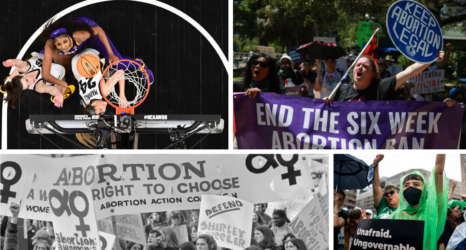This week, John Krakauer’s book, Missoula, “a depressingly typical” story about college town rapes, was released. In a recent NPR interview, Krakauer describes his dawning realization about how many women in the United States have been sexually assaulted, most often by people they know. His prior lack of awareness about women’s experiences, either of being assaulted or avoiding assault, is hardly rare.
A primary reason most people can remain blissfully unaware of the reality of sexual assault is that media continues to ignore the role that gender plays in the experience of violence. In December, for example, Gallup released its most recent assessment of a gendered safety gap in its annual U.S. crime survey, a report that garnered virtually no media interest. On the surface, the news looked generally good: “Most Americans,” researchers concluded, “continue to feel safe in their immediate communities, with 63 percent saying they would not be afraid to walk alone there at night.” However, the 63 percent number masks a difference: almost half of women, 45 percent, report not feeling safe, whereas 73 percent of men reported that they do.
What does this gap mean, why is it so persistent and why are we not talking about it? A man like Krakauer—informed, curious and educated—for example, admits to having had no prior sense of how this gap informs the lives of the women around him. Violence against women in the United States is emblematic of global realities.
Earlier this year, the United Nations released yet another report documenting “alarmingly high rates” of gender-based violence against girls and women. An estimated 35 percent of women worldwide experience a spectrum of intimate partner violence. In the United States, the gender safety gap, a measure of how physically secure men and women feel in the United States, has never dipped below double digits, something true of all industrialized nations.
The question asked by Gallup in its U.S. crime survey—“Is there anywhere near where you live, that is, within a mile, where you would be afraid to walk at night?”—was similarly posed in polls taken in 143 countries in 2011. December’s U.S. results lined up closely with European country results of that survey, which found that wealthier, more developed nations continue to have some of the largest gender safety gaps. That survey found that 75 percent of men in Europe said they felt safe, compared to 55 percent of women. Globally, 72 percent of men and 62 percent of women answer yes to this question. As Gallup researchers pointed out, these measures undoubtedly reflect different standards of safety, as well as commitments to women’s safety.
Explains Valerie Hudson, an expert on international security and foreign policy analysis at the Texas A&M Bush School of Government and Public Policy,
American women still worry whether what they wear on any given day will get them assaulted in their own neighborhoods; they must still worry when they get into a cab alone or when the repairman shows up at the door; they still cannot jog at night or go camping by themselves; they still give their date’s phone number to a friend so the police will know who to investigate if their body shows up in a shallow grave somewhere. Americans pride themselves on living in a progressive society. But, if we look solely at women’s level of physical security, the U.S. has nothing to crow about. It ranks firmly in the middle of the pack among the world’s nations in those terms.
Hudson, along with three collaborators, authored the groundbreaking book, Sex and World Peace, documenting relationships between women’s safety and equality, economic growth and militarism.
Crime researchers studying safety and how victimization is assessed tend to look at four factors: fear of crime, perceived risk, constrained behaviors and defensive actions. There are meaningful gender differences in all four of the areas measured by researchers, with women reporting higher levels of anxiety, perceptions of risk and adaptive behavior. Men, on the other hand, may have an exaggerated sense of confidence about their safety and control, and a gendered disinclination to admit to vulnerability (a feminization). They also demonstrate higher sensitivity to property crimes, whereas women, less able to consider home a safe haven from public, stranger-perpetrated crimes, are more alert to personal, physical risks. Historically, men were more likely to be the victims of violent crimes, however, according to the Department of Justice’s most recent crime report, between 2004 and 2013 rates of violent crimes against men and women reached equal levels of prevalence.
This safety gap is routinely ignored in attempts to find solutions to violent crime. Consider, for example, the recent argument made by the gun lobby and its supporters that “hot young girls” should carry guns to class to protect themselves against rape. This suggestion reflects a profound and dangerous ignorance about the nature of sexual assault and intimate partner violence. First, women being raped are unlikely to shoot the person assaulting them, often because that person is known to them, including relatives, intimate partners and friends (73 percent of sexual assaults are committed by someone known to the survivor). Studies indicate that guns are used defensively in sexual assaults in 0.1 percent of cases. Second, there are marked gender difference in considerations regarding the efficacy of guns. Pro-gun legislation is a gendered affair, particularly when linked to Stand Your Ground laws, which repeatedly fail women in their own homes.
Gallup’s “Guns in the Home: Safer or Not?” survey, published in November 2014, found that about “six in 10 Americans say guns make home safer.” However, that number is 67 percent of men, compared to 58 percent of women; 65 percent whites to 56 percent non-whites. Women are almost a third more likely to say that a gun in the home makes it a more dangerous place—and for good reason: Unlike a man, a woman in the United States is more than twice as likely to be killed by a man she knows than by a stranger, and she is often shot to death. Forty percent of women killed by partners are shot to death and a woman is more than 3.5 times more likely to be killed by an intimate partner than a man is.
Media continues to play a significant role in perpetuating misunderstandings and myths about violence against women. Stories tend to overemphasize stranger-perpetrated crimes, often in other countries. Recent stories, such as one about two students forced to fight off men who “eve-baited” them on a bus in India, another about the stalking and killing in Germany of a 23-year-old woman after she confronted men harassing two teenage girls in a bathroom, and a third about the rape of a young Turkish student on a bus are good examples. Even in domestic U.S. coverage, a sensationalized stranger focus prevails. Coverage of a case involving a man in New York who slashed a woman’s neck after she refused to go on a date with him and another about a woman in Detroit who was shot and killed by a stranger when she declined to share her phone number illustrate this tendency.
Stories about rapes involving acquaintances of the same race and class however are fewer and farther between, unless the spectre of false accusations is raised. Media analysis in the wake of Rolling Stone’s problematic article about a vicious gang rape, and the evolution of coverage, provides another good example of a sensationalized stranger rape case, an almost fetishistic focus on the victim’s actions and a penchant in media for stories that sympathize with perpetrators.
Media analysis shows that only 12 percent of cable news channels reported on the story before it became the topic of controversy regarding Rolling Stone’s journalistic approach. Fifty-seven percent, on the other hand, covered the story after a possible “rape hoax” became the leading narrative. At the same time, most people remain comparatively unaware of a concurrent Vanderbilt trial that found two men guilty of, and two more to be tried for, the brutal gang rape of a fellow student.
This gap is a measure of persistent and deep structural gender inequities that continue to marginalize women in the public sphere and to perpetuate unconscionably high levels of socially tolerated gender-based violence. As the work of Hudson and others shows, women’s physical security is a foundational dimension of societal equality and peace. A formal commitment to gender equality in the law has yet to mean that men and women benefit equally from societal improvements like lower crime rates, education, better health care, and greater comparative wealth, or enjoy anywhere near parity rights to physical freedom and security. On the contrary, many consider the gap a “natural” state of affairs and women’s absorption of the gap’s costs continues to be largely taken for granted.
Photo via Shutterstock
Get Ms. in your inbox! Click here to sign up for the Ms. newsletter.
Soraya Chemaly is a media critic and activist whose work focuses on women’s rights, free speech and the role of gender in politics, religion and popular culture. Her work appears regularly in a variety of media, including Salon, CNN, Huffington Post and The Guardian.





